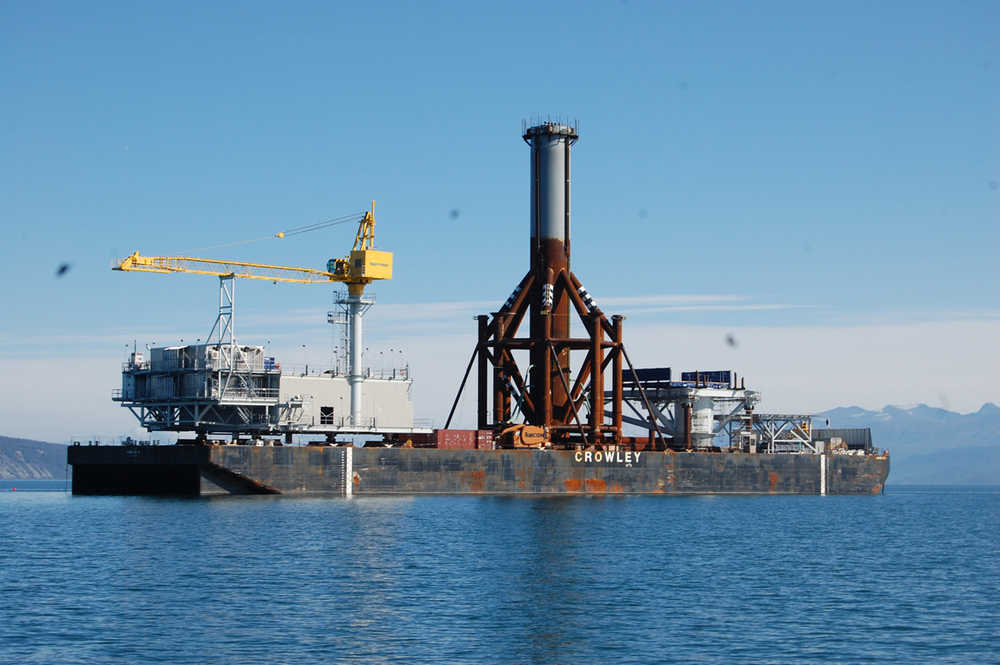Furie Operating Alaska will begin producing natural gas in November from a newly installed production platform at its Kitchen Lights gas discovery in Cook Inlet, the company said.
It has been a long haul for the company, which entered Alaska as Escopeta Oil and Gas several years ago.
The initial producing rate will be 15 million to 20 million cubic feet per day but that will increase as more customers are lined up, said Bruce Webb, a Furie vice president. The identity of the current customer cannot be disclosed, Webb said.
A 10-inch platform-to-shore pipeline now installed and almost complete will have a maximum capacity of shipping 100 million cubic feet per day and Furie’s plans call for second 10-inch pipeline, with equal capacity, when sales contracts allow for expansion.
The platform and other production facilities are designed to handle 200 million cubic feet per day, Webb said.
“The pipeline is just about complete with a tie-in of the offshore pipeline with the onshore pipeline. Onshore facilities are also almost finished,” he said.
At the platform, the pilings are complete and the “top-deck” will soon be installed.
The installations are being done with a special pipe-laying barge that is now offshore Kenai. The jack-up rig Spartan 151, under contract to Furie, is also stationed offshore, near the platform and is being used as a floating hotel for workers, Webb said.
Initial production will be from Furie’s Kitchen Lights Unit No. 1 well but two other wells will be brought into production in the first half of 2016, for a total of three wells supplying the contracted sales volumes.
Webb said the operation employed up to 400 workers in recent weeks but the workforce is now down to about 250. By the end of the year Furie will have invested about $500 million in its Kitchen Lights development, he said.
Furie’s development at Kitchen Lights has a long and complex history. The prospect was initially identified by Furie’s predessor company, Escopeta Oil and Gas, and its president, Danny Davis, an old-school oil exploration wildcatter from Texas.
Dwindling production of petroleum from Cook Inlet was becoming a concern but Davis and Escopeta’s geologists believed the Inlet has undiscovered resources, particularly in deeper waters that required a jack-up rig or floating drillship to explore.
Escopeta bid in state lease sales and acquired offshore acreage and Davis set about raising funds to bring a jack-up rig to Cook Inlet to drill untested offshore prospects, not only for Escopeta but for others as well.
An initial effort to bring a rig north in 2006 failed when Davis’ financing fell apart. A second effort, in 2010, was successful but the federal administration had meanwhile changed and an exemption from the U.S. Jones Act Davis had obtained from the Bush administration to use a foreign heavy-lift ship to move the rig was not renewed by the Obama administration.
Davis took a gamble that he could eventually persuade the U.S. Department of Homeland Security, which administers the Jones Act, to renew the exemption, and had the Spartan 151 rig loaded on board a Chinese heavy-lift ship. The rig was then in U.S. Gulf of Mexico waters.
Davis continued efforts to get the exemption as the ship rounded Cape Horn and headed north in the Pacific. The rig was actually unloaded in Vancouver, B.C., for maintenance, and U.S.-owned tugs were hired to tow it to Cook Inlet.
Even through the journey was broken, so that the Chinese ship moved the rig from a U.S. to Canadian port, the federal government still ruled it a violation of the Jones Act and hit Escopeta with a $15 million fine.
Davis, who had pioneered the effort, essentially lost his job as president over the issue, and Escopeta’s investors took the company over, renaming it Furie Operating Alaska. Davis still retains a small royalty in the property, however.
Furie used the Spartan 151 rig to drill the first exploration wells at Kitchen Lights and Davis’s foresight was vindicated when a gas discovery was made.
Tim Bradner can be reached at tim.bradner@alaskajournal.com.


